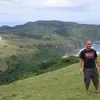












The farthest flung islands of the Philippines remain some of the least populated, which makes a trip to Batanes like a dream of a more idyllic past. I’ve been fortunate enough to spend plenty of time in the islands, which has allowed me to travel around a bit within Batanes. The history of this quiet province is anything but quiet, as it’s the most northern part of the Philippines and has seen invasions and occupations from the north.
The local Ivatan people managed to maintain their unique, mountain lifestyles from their arrival during the Neolithic Period (4000 years ago) until the Spanish required that they joined communities at lower altitudes at the end of the 18th century. Over the following century, Ivatans who traveled to Manila and became educated decided that Spanish rule was not for them, and in 1890 they killed General Fortea and declared Spanish rule to be over.
However, during subsequent wars, invaders often started with Batanes and the islands saw frequent changes of power. During World War II, the Japanese invaded and atrocities were certainly committed, as they were in much of the country.
The population is, of course, very mixed today. The Ivatans are still the main demographic community and the primary languages are Ivatan languages and Itbayaten. The culture is one of fishermen and farmers, and due to abundance of food, the people tend to live well.They are not, however, creating a booming economy. In fact, things move slowly, at a relaxed and reasonable pace. Tourism is definitely regarded as the next wave of economic growth, but if you hurry you can see Batanes before the character of the islands changes.
In addition, there are very old Spanish limestone bridges, which once served to connect the island inhabitants, creating roadways between villages and modernizing life in Batanes.
But it’s easy to fall in love with the natural beauty of these islands. In Batanes, the only distraction is the lack of distraction. Everything feels relatively untouched, from the beaches and forests, to incredible opportunities to see migrating birds in large flocks.
It’s always balmy in Batanes. January averages remain around 22C, while July averages hover near 28C. It’s always a good season to visit in Batanes, although August is when the islands get the most rain, while April is the driest month.
There are plenty of activities for the adventurous, including trailblazing up through the canopy in order to reach the bare rock of the peak. These and other activities were high points during my trip to Batanes, but all together the real value of the place is in the remoteness.
Yes, the weather is perfect. Yes, the islands are like unexplored treasures waiting to be seen. But for my taste, it’s the fact that these dots on the map are really far away from everywhere else. It just feels distant, and to go to a place that is distant and idyllic is what I want from an adventurous vacation.
With a friendly local population that is set in their ways, it’s easy to imagine what it was like here hundreds of years ago. It’s also easy to imagine that things will never change. No traffic, no pollution, no crime, and no stress. But Batanes has changed and it will change more, partly because people like me have discovered it and taken the time to share first hand impressions of a place that is all too often written off as being ‘in the path of typhoons’.
The Ivatans that remain on the island will soon see more visitors. My hope is that those visitors can respect and enjoy the pristine nature of the islands of Batanes, because we all need a place to escape to from time to time. Let’s hope that Batanes remains that place of escape, reflection, and renewed sense of exploration and adventure.






